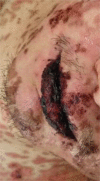Allopurinol-induced toxic epidermal necrolysis featuring almost 60% skin detachment
- PMID: 31232948
- PMCID: PMC6636951
- DOI: 10.1097/MD.0000000000016078
Allopurinol-induced toxic epidermal necrolysis featuring almost 60% skin detachment
Abstract
Rationale: Toxic epidermal necrolysis (TEN) is a life-threatening, immunologically mediated, and usually drug-induced disease. Rarely, clinical pharmacists participating in finding the etiology have been reported.
Patients concerns: A 33-year-old male presented to the emergency department with a 1-day history of fever and rash. The patient, being newly diagnosed with gout 10 days ago, received allopurinol at a dose of 250 mg by mouth daily. After 10 days' exposure to allopurinol, the patient manifested with an "influenza-like" prodromal phase (fever of 38°C, throat pains), which was treated with amoxicillin and nonsteroidal anti-inflammatory drugs of the oxicam type. The next day, he developed a worsening fever of 39.5°C, accompanied by a pruriginous rash all over his body.
Diagnosis: On physical examination, we observed coalescing dusky red macules over >60% of his body surface area, with blisters and detachment of large sheets of necrolytic epidermis all over his chest and face. The diagnosis of TEN was confirmed.
Interventions: The patient recovered following treatment with short-term high-dose methylprednisolone sodium succinate, immunoglobulin therapy, topical medication, and supportive therapy.
Outcomes: He showed a slow but progressive improvement both in symptoms and cutaneous manifestations. Reepithelization of the skin was achieved after 3 weeks.
Lessons: Drug-induced-TEN is potentially fatal. This case underlines the necessity of asking medication history in detail and detecting related drug gene to correctly identify the cause of TEN.
Conflict of interest statement
The authors report no conflicts of interest.
Figures
References
-
- Cartotto R. Burn center care of patients with Stevens-Johnson syndrome and toxic epidermal necrolysis. Clin Plast Surg 2017;44:583–95. - PubMed
-
- Chong HY, Lim YH, Prawjaeng J, et al. Cost-effectiveness analysis of HLA-B∗58: 01 genetic testing before initiation of allopurinol therapy to prevent allopurinol-induced Stevens-Johnson syndrome/toxic epidermal necrolysis in a Malaysian population. Pharmacogenet Genomics 2018;28:56–67. - PubMed
-
- Downey A, Jackson C, Harun N, et al. Toxic epidermal necrolysis: review of pathogenesis and management. J Am Acad Dermatol 2012;66:995–1003. - PubMed
Publication types
MeSH terms
Substances
LinkOut - more resources
Full Text Sources





